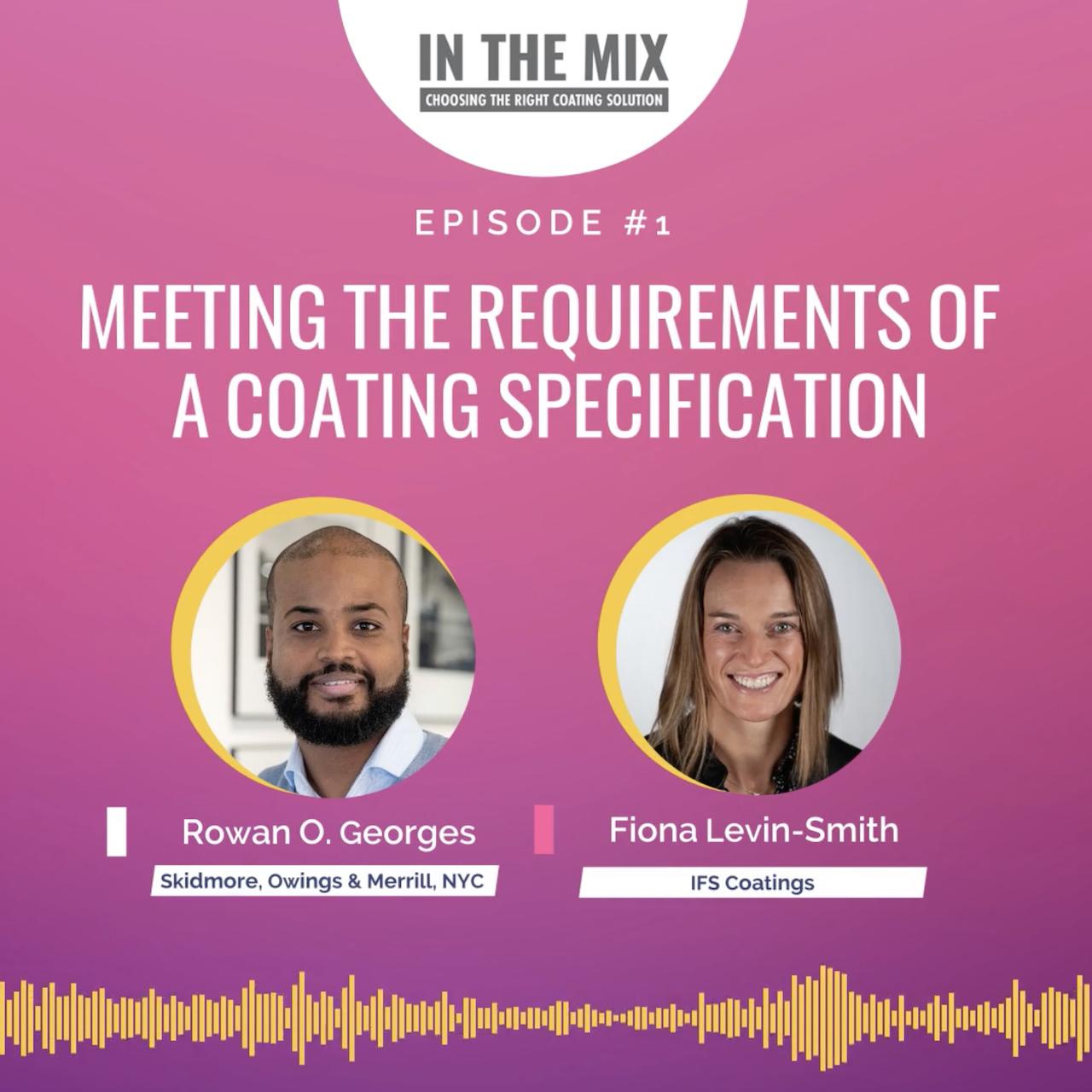In our first episode, Meeting the Requirements of a Coating Specification, we had the privilege of sitting down with two industry experts, Rowan O. Georges, Lead Specifications Writer at Skidmore, Owings & Merrill NYC, and Fiona Levin-Smith, Vice President of Marketing at IFS Coatings. This insightful conversation revolved around the evolution of design processes, the specification of coatings, and the pivotal role that sustainability plays in shaping the architectural landscape. Join us as we delve into their perspectives on the challenges and opportunities facing the industry today.
Rowan Georges has been an integral part of SOM for over 18 years, where he leads the specifications team in the New York office and oversees firm-wide specification writers. His extensive experience has made him a recognized figure in the world of architectural design and coatings.
Fiona Levin-Smith, with over 16 years of experience in powder coatings, currently works at IFS Coatings. Originally from Europe, she has been instrumental in bridging the gap between architectural specifications and coating technologies. Her role includes overseeing architectural specifications at IFS Coatings and providing valuable insights into coating choices.
The Architectural Specification Process:
Rowan Georges began by shedding light on the typical procedure that architects follow when specifying coatings for facades. Historically, the choice of coating colors and sheen is derived from a design or what’s been used in the past. The performance of the coating and the selection in the machine go hand in hand. They generally start with AMMA 2605-compliant. In recent years, there has been a shift towards using powder coatings due to their environmentally friendly nature, with an emphasis on their performance. Rowan emphasized the importance of using AMMA 2605 for monumental high-rise exterior projects and AMMA 2604 for interior applications, signaling a preference for environmentally responsible choices.
Environmental Considerations:
One of the key drivers behind the shift towards powder coatings is their environmentally friendly nature. Fiona and Rowan discussed the various aspects of this shift, highlighting the absence of solvents in powder coatings, leading to lower VOC emissions. They also emphasized the sustainability aspect, as unused powder coating can be reclaimed and reused, minimizing waste. The discussion also touched upon factors like manufacturing plant sustainability, embodied carbon footprint, and the use of environmental product declarations (EPDs) to measure sustainability.
LEED Certification and Sustainable Design:
The conversation shifted towards LEED certification and its role in sustainable design. Rowan explained that LEED 4.1 now offers credits for transparency documentation like EPDs and healthy product declarations. This shift towards sustainable design is becoming the norm in both public and private projects. Developers recognize the value of sustainability as tenants increasingly demand environmentally conscious buildings and fit-outs.
Additional Standards and Transparency:
In addition to LEED, Rowan emphasized the importance of other standards and transparency in coating specification. He highlighted the significance of the Red List and other similar organizations that measure material quality. He expressed the hope for standardized approaches to reduce the complexity of checking various lists, ultimately striving for both environmental and health-conscious material choices.
The Future of Powder Coatings:
When asked about their wishes for the future of powder coatings, Rowan and Fiona touched upon several areas. Rowan expressed the desire for improvements in the specular quality of AMMA 2605 powder coatings, particularly for monumental high-rise projects. Fiona shared insights into ongoing research and development, mentioning challenges related to pigment availability and the balance between aesthetics and weathering capability. They both praised the advancements made in powder coatings over the past decade.
Design Complexity and Innovation:
Discussing the evolving nature of design complexity, Rowan emphasized the influence of technology, automation, and artificial intelligence in architectural design. However, he highlighted the need for alignment between design and manufacturing processes. Fiona added that innovation is a constant in the industry, with designers pushing boundaries and materials evolving with technology.
Global Market Trends:
The conversation explored the North American market in comparison to other regions worldwide. Rowan noted that while North America traditionally favored liquid coatings, there has been a shift towards powder coatings, particularly in the Northeast. They emphasized the growth potential for powder coatings in steel curtain walls and steel components due to environmental considerations. Fiona highlighted the benefits of powder coatings on different materials, like steel and fiberglass.
Collaboration for a Sustainable Future:
Collaboration emerged as a central theme throughout the conversation. Rowan highlighted the importance of engaging with manufacturers, applicators, and ownership to promote sustainable practices. Fiona praised Rowan’s proactive approach in adding powder coatings to architectural specifications over the past decade, emphasizing the need for collaboration in pushing the industry towards sustainability.
In our conversation with Rowan Georges and Fiona Levin-Smith, we gained valuable insights into the evolving world of architectural design and coatings. Their dedication to collaboration and innovation serves as an inspiring example for the industry.
Listen and Download here.
Love our podcast? Don’t miss an episode! Be sure to subscribe and join our growing community of listeners. Thanks for listening!

Categories Webinars/News/Podcasts/Presentations